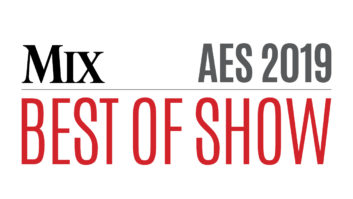Three Mix reviewers/editors—Mike Levine, Steve La Cerra and Barry Rudolph—walked the aisles of the Jacob Javits Convention Center in New York mid-October and picked the following Best of Show products.
Here, in no particular order, are the pro audio products they found.
Solid State Logic Origin

The big “star” of the show was SSL’s new Origin Console, smartly priced at $50K base. In less than 2 meters width, the Origin is an all analog, inline, dual-channel design, with 16 buses, E Series EQ and the Classic stereo Bus Compressor. It has new PureDrive mic pre that can switch character to a warm, harmonically rich and driven tone that varies with mic pre gain. There is a new mix bus and mix amp architecture said to deliver a low noise floor along with a high headroom summing bus. There are balanced insert points per channel path, dedicated channel direct outputs, stem-ready 0 dB fader bypass switches and a new center section that allows easy modification. The board comes in just one configuration with 32 large faders, 32 small faders, E-series Black Knob EQ and a 12U of rack space in a 19-inch wide center section in which you may add 500 racks or other outboard. There is also a place for a QWERTY keyboard and a position for a DAW screen, if desired. It is all analog with no automation or controller layer, no patchbay, and conforms to the new EU energy efficiency standards with a sleep mode where it consumes just 40 watts versus 1 kW when in operation.
Sonnox Oxford Drum Gate

This powerful plug-in provides intelligent detection, Adaptive Decay, Leveller and MIDI triggering. It also features precise transient detection and intelligent drum-type matching to separate the hits you want to keep from the spill you don’t. You can also create custom drum profiles to isolate unusual drum types or fix the occasional kick, snare or tom mismatch. The Decay curve adapts to the velocity of each drum hit, giving you consistent spill reduction on dynamic performances, and the Spectral Decay editor lets you preserve the resonance, ring or rattle of each drum hit while quickly clamping down on the spill. The Leveller’s dual target and amount controls let you improve level consistency without losing the contrast between loud hits and soft ghost notes.
Roswell Pro Audio Mini k87 Microphone

This small-sized large-diaphragm cardioid condenser mic sells for $349 and is designed for clean reproduction. It is the sibling to the existing Mini K47, which has a more “vintage” sound. The Mini K87 aspires to transparency rather than color. The mic’s sound comes from a combination of a specially tuned K67/K87-style capsule and a circuit that has been designed to enhance and complement it. The Mini K87 excels on vocals (sung and spoken, including voiceover and podcasting), guitars, acoustic strings and drum overheads. The Mini K87 goes through an extensive burn-in, QC and audio testing process prior to shipping in order to ensure that every microphone delivers solid performance out of the box. The Mini K87 ships with Roswell’s exclusive Cutaway shockmount, Roswell branded microfleece mic sock and an aluminum flight case.
Soyuz The Launcher

The Launcher is not meant to be transparent and clean like other gain boosters on the market. The Launcher makes your mics sound like they’re running through a vintage console—even when they’re plugged into a simple interface or P.A. system. With its custom hand-wound transformer, the Launcher’s warm character will change the way you look at dynamic and ribbon microphones. Whether on the stage, in the booth, or in your bedroom, the Launcher gives your microphones the ability to perform with virtually any interface or preamp by optimizing the sound of your source, boosting your gain by 26 dB and lowering the amount of audible noise in your signal chain.
Cranborne Audio 500R8

It’s an audio interface, it’s a 500 series rack, it’s a summing amp—the 500R8 has everything you need to build your dream analog/digital hybrid studio, including a USB Audio Interface that connects directly to your PC/mac via USB and uses the 500R8’s built-in 28-in/30-out USB audio interface for recording and playback directly to/from your chosen DAW. It also features a Monitor Controller that allows you to switch between two sets of speakers, toggle Mono sum, Mute, Dim and Talkback facilities while monitoring the peak level of your mix with 28 segments of LED detail. The 500R8’s Zero Latency Artist Mixer lets you monitor live sources in the analog domain with zero latency by using dedicated mix level and pan controls per-channel combined with the high-powered headphone amps. Finally, the Discrete Summing Mixer can sum eight USB sources through the 500 series modules and into the discrete analog summing mixer to be summed and recorded back into your DAW as a stereo track.
United Studio Technologies UT FET47 Condenser Microphone

United worked with capsule designer and manufacturer Eric Heiserman to develop a commercially produced version of his German style dual-backplate K47 capsule. This process required the analysis of everything from the sourced Mylar to the thread types of screws; but after many months and many iterations, they finally achieved what they had hoped for in the HZ Series capsules. While many of the HZ Series design secrets will remain so, one attribute United revealed is the use of dual, matched backplates. With the HZ Series matching process, a far more accurate and consistent quality from side to side and capsule to capsule is achieved. The HZ series capsule is still manufactured only a few at a time, stringently listened to, and only are used if they meet both United’s and Heiserman’s expectations. The UT FET47 also includes a Cinemag output transformer, which is a large transformer made from a striped core of interleaved sets of high nickel and steel laminations. Its humbucking design delivers clean and quiet operation.
Tonelux JC37 Microphone

The Tonelux JC37 is a cardioid-only version of the Sony C-37a. The “JC” is for Joe Chiccarelli; he and Sunset Sound have quite a collection of the original mics to reference. The Sony C-37a was always a favorite for snare drums, brass and solo trumpet, piano, acoustic guitar and vocals. Retaining the base elements of the original design—a vacuum tube buffered 37mm single diaphragm transducer with transformer output, the JC37 foregoes selectors for pattern, frequency response, output impedance and level of the original in favor of a cleaner signal path. As with the mic stand mount, a 3-meter cable is integrated into the body of the mic and connects to a Tonelux Universal Microphone Power Supply that is capable of powering two microphones as a stereo setup. Price is $4300 a pair.
Steinberg WaveLab 10 Mastering Software

WaveLab 10 introduces a new track type in the Audio Montage workspace, the Reference Track. This allows you to add a reference audio file and switch playback between the reference track and the montage tracks that you are working on, without any glitches or latency. A Reference Track can be routed to the main outputs, to the Playback Processing Section or to a user-defined reference track output, where unused audio outputs on your hardware can be utilized for playback. It also comes with video file playback in the Audio Montage, allowing you to arrange, edit and process the audio of a video. With WaveLab 10, you can now integrate other audio editors (like SpectraLayers or iZotope RX) into your WaveLab workflow, giving you the option of modifying an audio file range (in the Audio File Editor) or an audio clip range (in the Audio Montage) in other editors, directly from within your current WaveLab session.
Microtech Gefell M Cube Microphone System

The M Cube is a 9-channel microphone system for time-delay-based 3D recordings. The nine microphones are arranged in the shape of a cube with a length of approximately 1 meter each side. The positions of the microphones are adjustable—so the dimensions of the microphone arrangement can be adjusted to the dimensions of the room and the sound source. The mounting bars have distance markings, so that any setting can easily be repeated. Five M 102 capacitor microphones are used for the lower plane and four M 221 capacitor microphones are used for the upper plane. All the microphones are omnidirectional pressure microphones. Price is $20,000.
AEA KU5a Ribbon Microphone

The supercardioid KU5A breaks new ground in ribbon technology with its acutely focused directionality that rejects bleed from other instruments, room reflections and loud ambience in the studio and on stage. As a near-field ribbon designed for close-range recording, the KU5A delivers the low-end heft and pronounced midrange one expects of AEA ribbons and with moderate, manageable proximity effect. Vocalists can sing directly into the grille of the KU5A, as its interior components are the most protected of any in the AEA lineup. The KU5A is equipped with active electronics, fit for any preamp in the studio and on the road, as well as an integrated high-pass filter to roll off low end in close range recording applications. Price is $1119.
Pultec EQM-1S Mastering Equalizer

The EQM-1S is the mastering version of the EQP-1S with a full-range progressive-taper Elma Switch stepped controls instead of continuous variable pots. The EQM-1S’ Boost/Atten controls provide 0.5 dB steps for the initial 50 percent of rotation and then increase step size as the rotation is increased toward 100 percent. This gives you the fine control you need for subtle boosts and cuts that are commonplace in mastering and mix-bus applications, while still delivering the full range (16 dB–20 dB) of Boost/Atten for more aggressive applications during tracking. In addition to adding mastering controls, Pultec has replaced the EQP-1S’s 6 kHz peak boost center frequency with the 16 kHz center. Price is $4895.
Eventide H9000 and H9000R Multi-Effects Processors with Version 1.1 Software

The studio staple has been significantly updated with a new bank of Vintage Emulations such as H3000 Micropitch, Unitide, SP2016 Reverb, Instant Phaser Mk II and Instant Flanger Mk II. You also get the new HotSawz algorithm and a bank of 3D Tools and Surround algorithm, as well as a 5.1 panner. This version allows each Effect Chain to support up to 32 channels of I/O, map parameters to external controllers or MIDI and provides support for DAW automation on Mac/PC/VST/AU/AAX. The H900 with full front panel user interface is $6999, while the blank front panel H9000R is $4999 and requires the remote V1.1 update.
Apogee Clearmountain Domain plug-in

For Domain, Bob Clearmountain has created presets based on specific instruments and vocal processing from his big hit records. There are five processors in a single plug-in: delay, pitch-shifted delays, and three personalized convolution reverbs with many internal parameters for each that can be tweaked to taste. According to the company, Clearmountain has carefully created each preset based on specific instruments and processing from his extensive catalog of timeless hit mixes. Looking to nail the Bowie “Let’s Dance” guitar and vocal delay or the Springsteen “Born in the USA” snare sound? Simply load the presets! Price is $349.
Nugen Audio SigMod Plug-In Update

SigMod is a single-process plug-in that now has 12 modules. With it you can add mid/side functionality to classic stereo compressor and EQ emulations, or get creative with mid/side delays, distortion and many other effects by inserting the mid/side encoder/decoder either side of any left/right plug-in instance. Insert the Protect unit across your output bus and this safety module will automatically cut in to prevent bursts of noise or feedback howls due to system errors, saving both your nerves and your speakers. Use the Crossover module to split the highs from the lows and apply different effects to different frequency ranges, which is great for avoiding muddying up the low frequencies or getting creative with automation and sweep effects. There is also a dual-mono option that allows for independent processing of two parallel channels.
Dynaudio Core 47

The Core 47 is a three-way compact monitor with a frequency range of 13 Hz to 200 Hz, 120 dB, all in a small cabinet. It has both analog and AES/EBU digital inputs and weighs over 100 pounds. Core 47 fills the gap between the Core 7 and Core 59 models. Its footprint is comparable to Core 7, but it’s a three-way design with a dedicated midrange driver for the highest degree of detail when reproducing sound in the critical frequency area—where, for instance, vocals are located. Core 47 supports up to 24-bit/192 kHz signals, and the internal DSP operates at the same high level when using the analog inputs. For amplifying Core 47, three Pascal Class-D amplifiers offer a total of 1150 watts power. MSRP is $4000.
Metric Halo Labs 3d Family

Metric Halo’s ULN-8 3d is the result of the company’s 20-year research program into the fusion of digital and analog audio technologies. It is a one-stop shop for all of your audio needs. The combination of ULN-8 3d’s transparent microphone preamps and Metric Halo’s insertable Character Component Modeling Processing provides flexibility and sound quality that’s hard to find. All 3d devices feature MHLink—Metric Halo’s audio interconnect technology. MHLink and 3d enable true multibox operation. Multiple units connected via MHLink automatically share a common clock, mix engine and computer interface. As a result, you interact with all your 3d units as one unified device—even if you spread them around your recording space with long spans of MHLink (Cat5e) cable between units.
1 Sound MS34 Loudspeaker

The MS34 is a 2-channel, point-source loudspeaker. As a standalone mono loudspeaker (switch and preset dependent) it can become a horizontal line source, helping to preserve its off-axis frequency response while adding 4 dB of gain. This loudspeaker can be used as a front fill, under balcony, monitor, or as part of an installed distributed system. The M+S/Mono Switch transforms the MS34 into a mono line source (vertical or horizontal) with 5 dB more output than MS mode.
Waves eMotion LV1 Proton

The Waves Audio eMotion LV1 Complete Live Mixing System incorporates everything needed to create live sound experiences in an all-inclusive mixing solution. The system allows transition between disparate productions such as musical performance and conferences (the latter facilitated by the use of dedicated Dugan Automixer and Dugan Speech plugins). Further, the LV1 Complete Mixing System is scalable—users can expand the system I/O count from 16 to 32, to 64 and beyond—and is compatible with Waves’ TRACT System Calibration plugin for rapid hall analysis. The comprehensive system includes the Waves eMotion LV1 16-stereo-channel live software mixer, a SoundStudio STG-1608 stagebox, a SoundGrid Impact Server-C, an Axis One Waves-optimized computer, a 24-inch Dell touchscreen, an eight-port network switch and network cables.
Pliant Technologies MicroCom

Available in 900 MHz (where legal), MicroCom provides single channel, full-duplex, multi-user intercom for applications where high-quality audio and excellent range are essential. MicroCom has the capability to provide unlimited listeners without the need for basestations, providing a great deal of flexibility. This compact wireless intercom is ideal for houses of worship, videographers, corporate events, schools, and a wide array of other applications. The system features small, water-resistant lightweight beltpacks and provides excellent sound quality, ease-of-use, and long-life battery operation. Additionally, MicroCom is designed with advanced RF technology and its software is tailored for professional use. Several different headset options are also offered that are suitable for a wide array of application needs.
Audio Precision APx500 Flex Audio Analyzer

The APx500 Flex audio analyzer—comprised of APx500 measurement software and an APx500 Flex Key—allows you to select the ASIO-capable audio interface of your choice to use along with AP’s APx audio measurement software. Start with the measurement options you need now, with the freedom to add additional measurements as your test requirements evolve. The APx500 user interface is fast and intuitive. Just click to select a measurement, then click to add a filter and drag limits to set pass/fail points right on the results graph. The APx generator can output steady tones, twin tones, sweeps, chirps, multitones or play WAV files as arbitrary waveforms.







